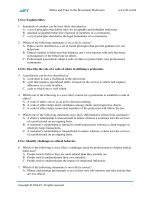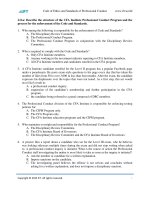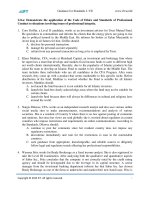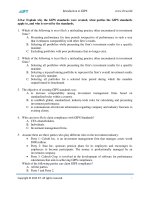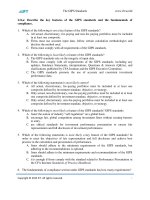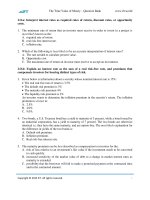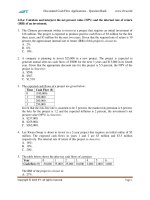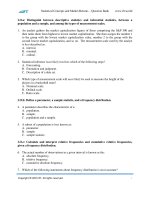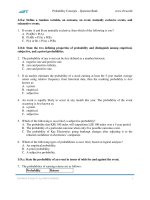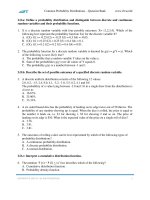CFA 2018 quest bank level 2 corporate finance industry company analysis
Bạn đang xem bản rút gọn của tài liệu. Xem và tải ngay bản đầy đủ của tài liệu tại đây (296.39 KB, 8 trang )
Industry and Company Analysis – Question Bank
LO.a: Compare top-down, bottom-up, and hybrid approaches for developing inputs to
equity valuation models.
1. Pharma Inc. is a large-cap company in the pharmaceutical industry. Rudy is an analyst at
Bears Investment and is forecasting Pharma Inc.’s revenue for valuation purposes. He
estimates the total market for drugs and calculates Pharma Inc.’s market share to be 12%.
The drug market is expected to grow to USD 25 billion next year from the current level of
USD 20 billion. Based on the total market value and Pharma Inc.’s market share, Rudy
calculates Pharma Inc.’s revenue for next year. The adopted approach is most likely classified
as a:
A. top-down approach.
B. bottom-up approach.
C. hybrid approach.
2. Which of the following is not an example of a bottom-up approach to forecasting revenue?
A. Time series forecast.
B. Return on capital based forecast.
C. Growth relative to GDP growth.
LO.b: Compare “growth relative to GDP growth” and “market growth and market share”
approaches to forecasting revenue.
3. Which of the following statements is least likely true?
A. In the growth relative to GDP growth approach, the company’s position in the industrial
lifecycle is an important input to determine growth.
B. In the market growth and market share approach, the analysis involves estimating first the
revenue growth in a particular market.
C. Both the “growth relative to GDP growth” and “market growth and market share”
approaches begin with estimating the growth in company’s capacity.
4. Which of the following is an example of a top-down approach to forecasting revenue?
A. Growth relative to GDP growth.
B. Market growth and market share.
C. Both growth relative to GDP growth and market growth and market share.
LO.c: Evaluate whether economies of scale are present in an industry by analyzing
operating margins and sales levels.
5. ABC Ltd. is a leading manufacturer of shoes. Over the past three years the company has seen
rapid growth in revenue and margins which has led to higher profits. Upon a closer
examination of the financial statements, an analyst finds that the output of the company has
declined over the last three years due to production issues but the company has been able to
raise prices as competitors withdrew from market. At the same time, raw material prices fell
due to oversupply. Which of the following statements is most likely true?
A. The company has seen growth in revenue and margins so is experiencing economies of
scale.
Copyright © IFT. All rights reserved.
Page 1
Industry and Company Analysis – Question Bank
B. The increase in profits is not attributable to economies of scale.
C. The benefits of economies of scale will decrease if the company’s raw material costs
increase.
LO.d: Forecast the following costs: cost of goods sold, selling general and administrative
costs, financing costs, and income taxes.
6. John Don, an analyst at Prime Capital, is forecasting the earnings of B&B Foods for the
upcoming year. He collects the information related to the recent income statement given
below:
B&B Foods Income Statement for the Year 2015
$ ’000
Sales
50,000
Cost of Goods Sold
24,000
Gross Profit
26,000
Selling Expenses
5,000
Administrative Expenses
8,000
Finance Cost
4,000
Profit before tax
9,000
Taxation expense
2,700
Profit after tax
6,300
Sales are expected to grow by 20%.
Gross profit margin is expected to increase by 0.5%.
Selling expenses to remain constant as a percentage of sales.
Administrative expenses are expected to increase by 10%.
The total debt at the beginning of 2015 was $50,000,000 and during the year the
company repaid $4,000,000 of its debt outstanding.
The expected profit after tax for the next year (2016) is closest to:
A. $9,600
B. $8,800
C. $9,100
LO.e: Describe approaches to balance sheet modeling.
7. Dura Cement is a large cement producer which provides its product to customers on credit.
The company usually maintains its receivables at 60 days of sales. In the coming year, the
management forecasts that sales are expected to decline as demand remains weak. The
company decides to allow longer payment periods to customers. Which of the following
statements is most likely correct?
A. Receivables will decrease.
B. Receivables will increase.
C. The impact on receivables is uncertain.
8. XYZ Co. plans to maintain its total debt-to-asset ratio at 40%. Last year, the total debt
amounted to $50,000. This year the company expects to generate an after-tax profit of $5,000
Copyright © IFT. All rights reserved.
Page 2
Industry and Company Analysis – Question Bank
which will be retained. XYZ also plans to raise fresh equity worth $15,000. The total debt by
the end of the year is expected to be:
A. $63,333
B. $58,000
C. $50,000
LO.f: Describe the relationship between return on invested capital and competitive
advantage.
9. Which of the following is most likely to increase return on invested capital?
A. Discounts offered to increase sales.
B. Product awareness leads to higher earnings without new investment.
C. Increase in government regulations.
10. When comparing performance of companies in countries with different tax structures, which
of the following is the most useful metric?
A. Return on equity.
B. Return on invested capital.
C. Return on capital employed.
11. Which of the following statements is true?
A. Return on invested capital is defined as net operating profit divided by the difference
between operating assets and operating liabilities
B. High and persistent levels of ROIC may indicate competitive advantage.
C. ROIC is unaffected by economies of scale
LO.g: Explain how competitive factors affect prices and costs.
12. Which of the following will least likely result in greater pricing power for companies in an
industry?
A. Availability of fewer substitutes.
B. High switching costs.
C. Identical product offerings.
13. Which of the following will most likely result in lower input costs for a company?
A. Fewer options available for raw material.
B. Large relative size of the supplier.
C. Fragmented supplier industry.
LO.h: Judge the competitive position of a company based on a Porter’s five forces analysis.
14. Rene Co. sells plastic crockery. It operates in a market where customers have low switching
costs and products are not very different. However, capital investment is not very high. The
company most likely:
A. faces low threat of new entrants.
B. finds it difficult to exit the industry.
Copyright © IFT. All rights reserved.
Page 3
Industry and Company Analysis – Question Bank
C. has low pricing power.
15. Which of the following most likely causes a lower threat of new entrants to an industry?
A. The presence of higher returns than other industries.
B. Higher investment costs relative to other industries.
C. Absence of government regulations.
LO.i: Explain how to forecast industry and company sales and costs when they are subject
to price inflation or deflation.
16. Which of the following would find it the easiest to pass on inflation cost to customers?
A. A packaged milk supplier selling to large retail stores.
B. A bespoke suit designer serving high end customers.
C. A tool supplier operating in an industry with many suppliers.
17. Company A sells two products X and Y. Sales volume and price data along with expected
price inflation for each is given below:
X
Y
Total Sales
$75,000
$105,000
Expected volumetric growth 6%
8%
Expected price change
5%
-2%
The total expected sales of Company A are closest to:
A. $185,000
B. $195,000
C. $205,000
LO.j: Evaluate the effects of technological developments on demand, selling prices, costs,
and margins.
18. Which of the following can be affected by technological changes?
A. Demand of a product only.
B. Quantity supplied of a product only.
C. Both demand and quantity supplied of a product.
LO.k: Explain considerations in the choice of an explicit forecast horizon.
19. Which of the following statements is most likely true?
A. Projected holding period is not a relevant factor in the choice of a forecast period.
B. Cyclicality of an industry is not a relevant factor in the choice of a forecast period.
C. Investor's portfolio turnover is a relevant factor in the choice of a forecast period.
LO.l: Explain an analyst’s choices in developing projections beyond the short-term forecast
horizon.
20. Which of the following factors should an analyst most likely consider while establishing a
terminal value multiple?
Copyright © IFT. All rights reserved.
Page 4
Industry and Company Analysis – Question Bank
A. Historical multiples even if future growth differs from past.
B. Comparative multiples of other industries.
C. Long-term growth expectations and required rates of return of the company under
consideration
21. Which of the following statements is most likely true?
A. Cash flow used to calculate the terminal value as a perpetuity should not be a normalized
cash flow.
B. Economic disruptions, regulations and technology can be potential inflection points in
developing a long term forecast.
C. The type of industry is irrelevant when determining a long term growth rate.
22. Which of the following is least likely a method used to calculate terminal value for a
company expected to last indefinitely?
A. Historical-multiples approach.
B. DCF approach.
C. Liquidation value.
LO.m: Demonstrate the development of a sales-based pro forma company model.
23. Which of the following is most likely a starting point in developing a pro forma company
model?
A. Industry overview.
B. Medium term cash flow forecast.
C. Estimating terminal value.
24. Which of the following statements is most likely true?
A. Revenue forecasts can be done with a combination of top-down and bottom-up
approaches.
B. A bottom-up approach to forecasting revenue is more accurate than a top-down approach
because it focuses on the company's individual product forecasts.
C. A top-down approach to forecasting revenue is more accurate than a bottom-up approach
because it focuses on important economic variables impacting the company.
25. Company D made sales of $65,000 last year and cost of goods sold were $39,000. Sales are
expected to increase by 10% whereas costs of goods sold are expected to decline by 1% as a
percentage of sales. The expected gross margin is closest to:
A. 40%
B. 41%
C. 42%
Copyright © IFT. All rights reserved.
Page 5
Industry and Company Analysis – Question Bank
Solutions
1. A is correct. The mentioned approach is the market growth and market share approach which
is a top-down approach. Section 2.1.1.
2. C is correct. Growth relative to GDP growth is a top-down approach. Section 2.1.2.
3. C is correct. This statement is not true because estimating capacity growth is a bottom-up
approach whereas both “growth relative to GDP growth” and “market growth and market
share” approaches are top-down approaches. Section 2.1.1.
4. C is correct. Both growth relative to GDP growth and market growth and market share are
examples of top-down approaches. Section 2.1.1.
5. B is correct. The increase in margins is due to lower raw material costs and higher per unit
price. This does not constitute economies of scale as economies of scale occur when the
company’s average costs per unit of a good or service produced falls as production increases.
Section 2.2.
6. C is correct. The calculation in ($ thousands) is as follows:
2015
Comment
Sales
50,000
Increase by 20%
Cost of Goods Sold
24,000
Difference between Sales and COGS
Gross Profit
26,000
52% margin last year, 52.5% next year
Selling Expenses
5,000
10% as percentage of sales
Administrative
8,000
Increase by 10%
Expenses
Finance Cost
4,000
50,000,000 debt implies 8% interest, next
year finance cost would be 8% x
46,000,000
Profit before tax
9,000
Taxation expense
2,700
30% tax rate
Profit after tax
6,300
Sections 2.2, 2.3.
2016
60,000
28,500
31,500
6,000
8,800
3,680
13,020
3,906
9,114
7. C is correct. As sales will decrease but receivable days will increase, the impact on
receivables is uncertain. Section 2.5.
8. A is correct. Based on a debt-to-asset ratio of 0.40 and debt of $50,000, the value of assets is
= $125,000 out of which equity is 125,000 - 50,000 = $75,000. The profit and fresh issue will
increase equity by $20,000 from 75,000 to 95,000. As equity is 60% of assets, total assets
will be 95,000/0.6 = 158,333. Hence debt will be 158,333 - 95,000 = 63,333. Section 2.5.
9. B is correct. Higher earnings without capital investment increases return on capital.
Discounts offered do not guarantee higher sales and ROIC. Increase in regulations usually
result in tighter profit margins. Section 2.5.
Copyright © IFT. All rights reserved.
Page 6
Industry and Company Analysis – Question Bank
10. C is correct. The return on capital employed (ROCE) is a pre-tax return measure that can be
useful in the peer comparison of companies in countries with different tax structures. Section
2.5.
11. B is correct. High and consistent ROIC implies a competitive advantage. Section 2.5.
12. C is correct. A uniform or identical product offerings by incumbent companies limits pricing
power. Section 3.
13. C is correct. When suppliers are fragmented, they have limited pricing power therefore input
costs are likely to be lower. Section 3.
14. C is correct. When switching costs are low and product offerings are more or less identical,
pricing power of companies is limited. Section 3.
15. B is correct. When higher investment costs exist, competitors generally find it difficult to
enter the industry. Section 3.
16. B is correct. A customized suit supplier sells unique products where inflation can be passed
on easily to customers. A tool supplier will find it difficult to do so due to large number of
competing suppliers and a milk supplier to large retail stores will have low bargaining power
due to the large size of the customer. Section 3.
(
17. B is correct. Total expected sales for X =
(
)(
)
sales for Y =
Section 4.1.2.
)(
)
. Total expected
. Total expected sales for Company A =
18. C is correct. Both demand and/or quantity supplied of a product can be affected by
technological changes. Section 5.
19. C is correct. Investor's portfolio turnover is a relevant factor in the choice of a forecast
period. Section 6.
20. C is correct. Long term growth rates and required return should be considered when
developing terminal value multiples. Past multiples can often be a poor estimate of terminal
value multiples when business dynamics are subject to change. Comparative multiples should
be used from the same industry as the subject company. Section 6.
21. B is correct. It is true that economic disruptions, regulations and technology can be potential
inflection points in developing a long-term forecast. Section 6.
22. C is correct. Liquidation value represents value from selling the company's assets. It is not
used for companies expected to last indefinitely. Section 6.
Copyright © IFT. All rights reserved.
Page 7
Industry and Company Analysis – Question Bank
23. A is correct. A model typically starts with an industry overview. Short term cash flow
forecasts are then done followed by medium term forecasts. Terminal value calculation is
typically done at the very end. Section 7.1.
24. A is correct. Revenue forecasts can be done with a combination of top-down and bottom-up
approaches. Neither approach can be labeled more accurate than the other. Section 7.3.1.
25. B is correct. Expected sales are 65,000 x 1.1 = $71,500. Last year cost of goods sold were
39,000/65,000 = 60% of sales. Next year they would be 59% of sales = 71,500 x 0.59 =
42,185. Gross profit would be 71,500 - 42,185 = 29,315. Gross margin would be
29,315/71,500 = 41%. Section 7.3.2.
Copyright © IFT. All rights reserved.
Page 8
